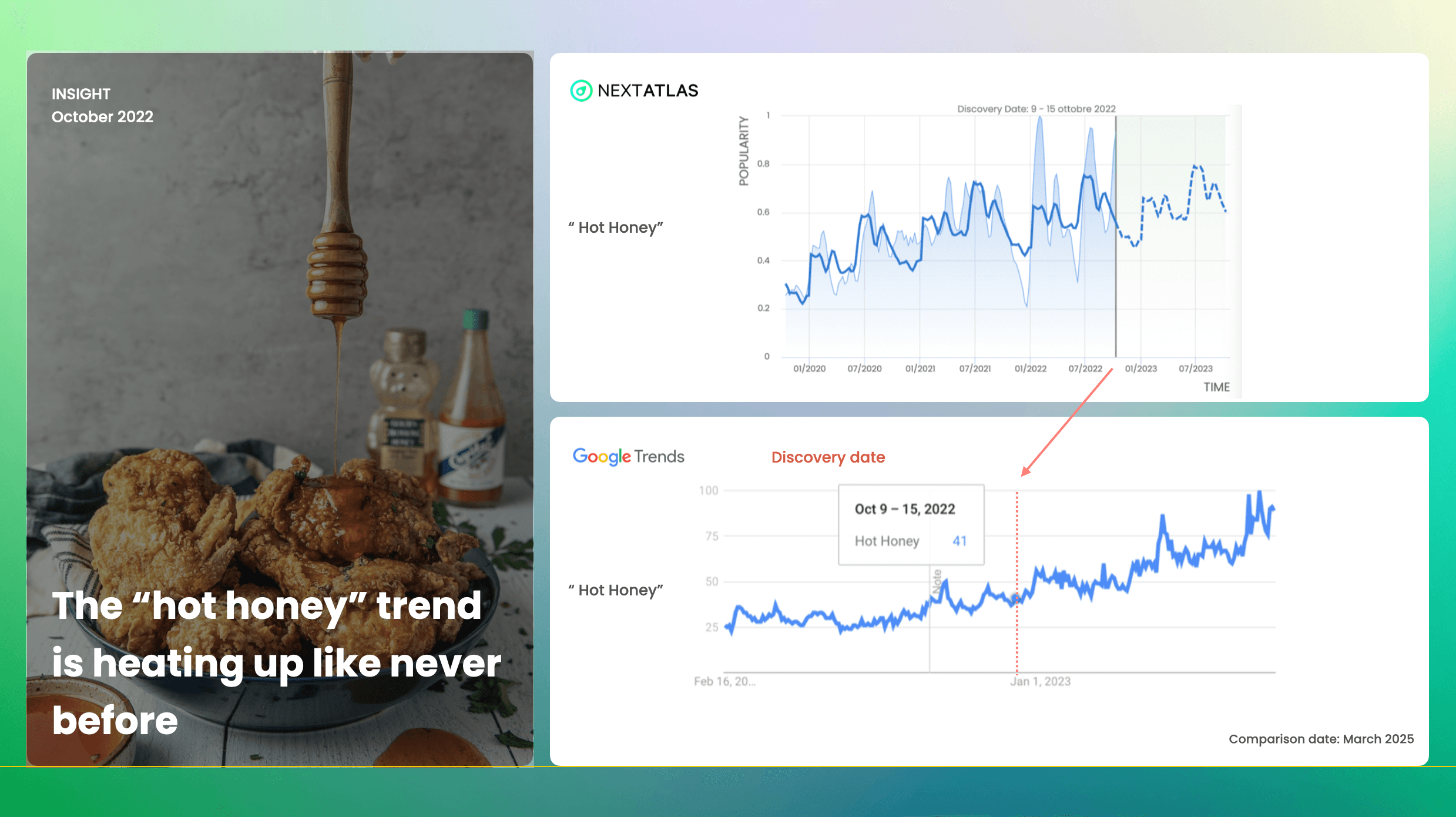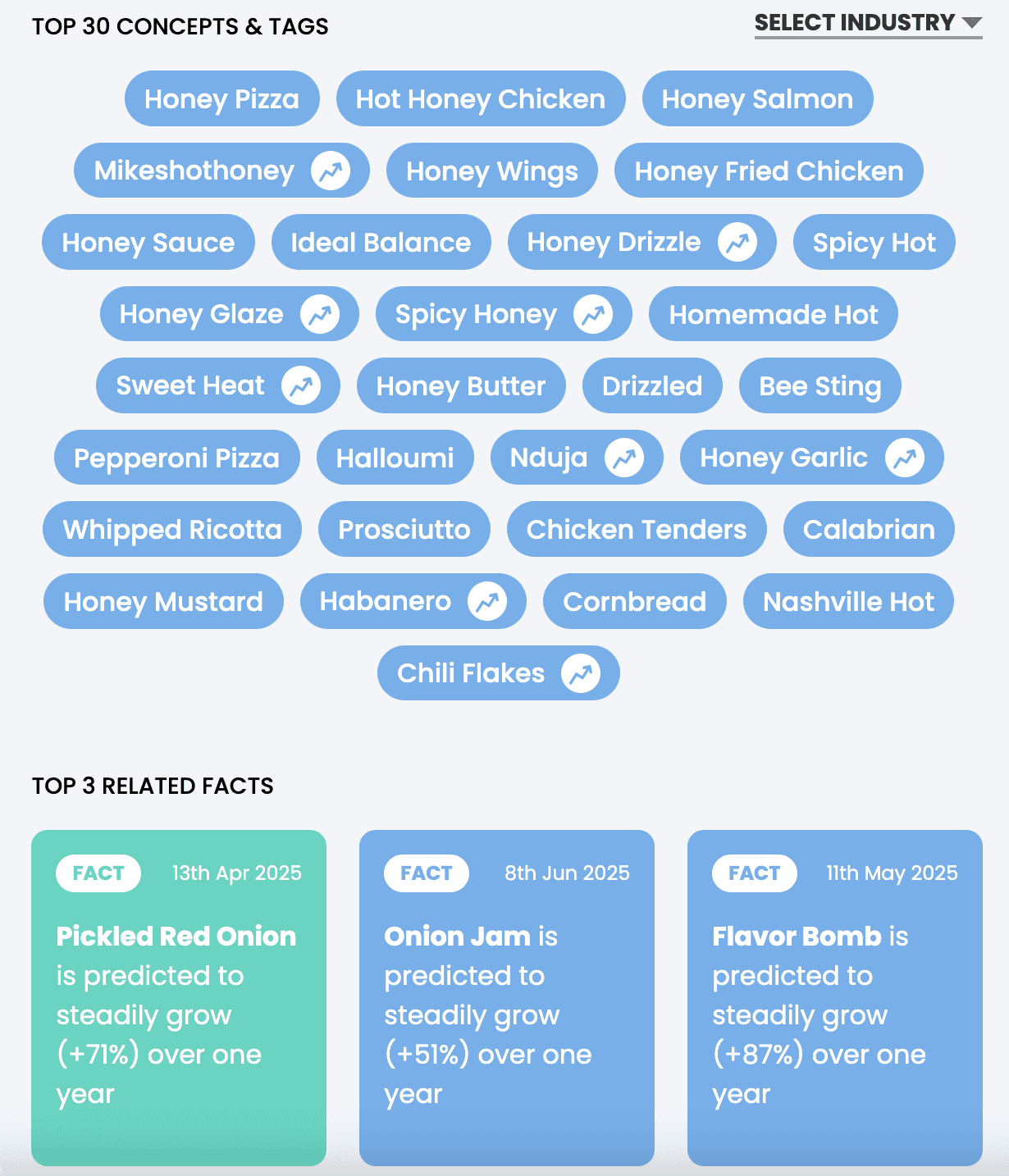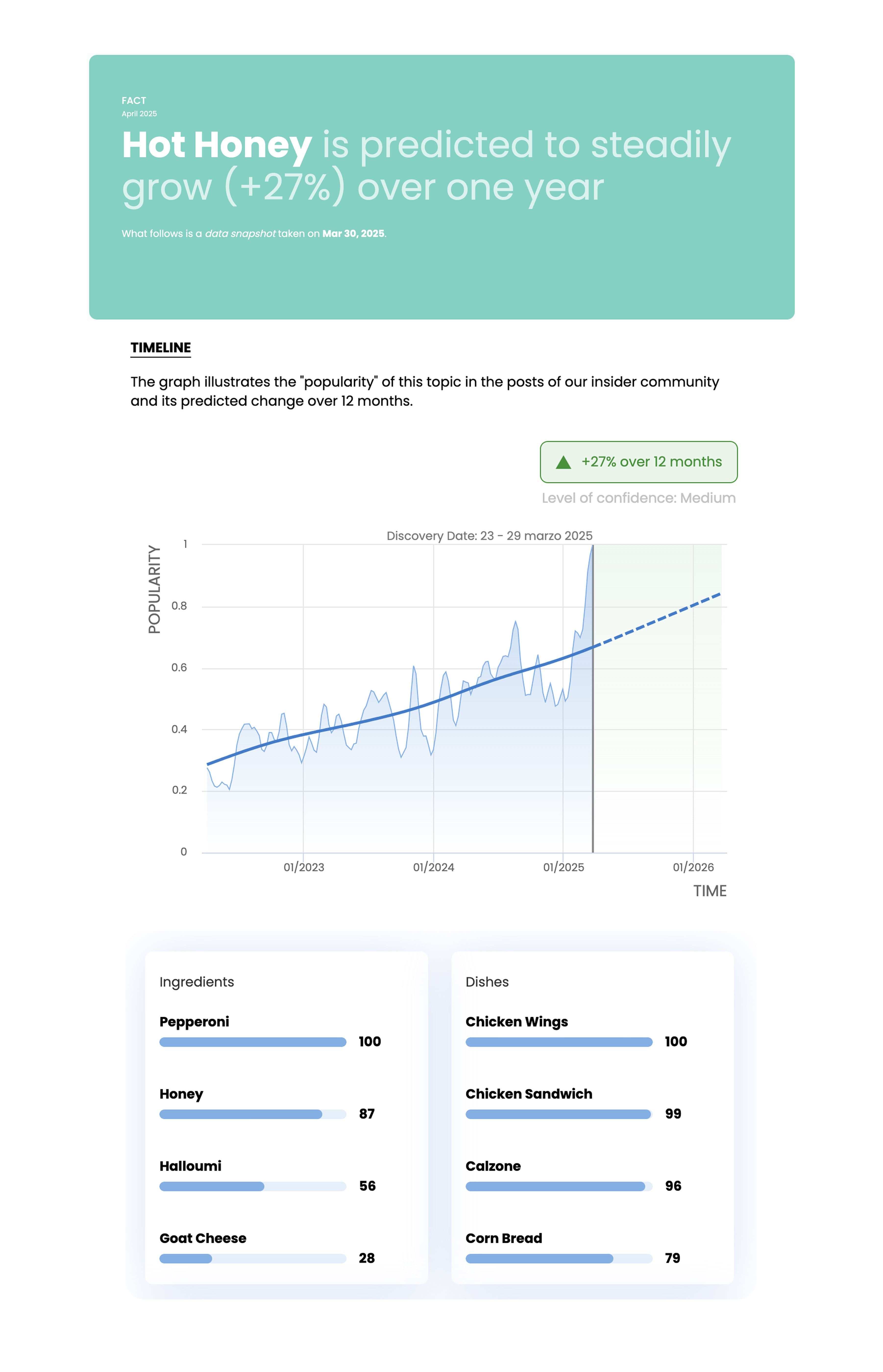We Spotted the Hot Honey Trend Before It Went Fully Mainstream
FOOD & BEVERAGE
From its humble beginnings in a pizzeria to viral TikTok recipes and fast-food menus, hot honey has become a global flavour phenomenon. The sweet-meets-heat sensation has captured consumer attention, but we predicted this current boom 2 full years before after close monitoring of early adopters online using the condiment back when it was niche.

Hot honey went from niche garnish to mainstream obsession involving major food chains, media validation, and viral TikTok recipes. But before any of that happened, we spotted it. When trend detection is done right, you ride ahead of the trend wave. Anyone who had access to Nextatlas' food trend tracking and prediction capabilities would have seen the rise and rise of the sweet but spicy condiment.
We Detected the Early Trend Signal
In October 2022, our trend detection technology picked up a significant shift from our early adopter conversations. Mentions of “hot honey” were climbing steadily across social platforms. It wasn’t loud yet, but it was persistent, growing, and culturally charged. When we cross-checked our detection date with Google Trends data, it's clear that we identified hot honey before it passed the threshold that often precedes rapid trend acceleration. Google searches for "hot honey" did not rise for nearly a year after. Nextatlas’ data was clear; something spicy-sweet was coming.

Our platform identified hot honey as a trend in late 2022. Google searches started climbing after this, validating our early signal detection
However, by the time we picked up early data signals in October 2022, the groundwork had already been laid by a decade of culinary experimentation, particularly in pizza circles. Our methodology is perfectly built to detect and monitor a trend like this.
We crawl through millions of social web posts from Twitter, Instagram, Reddit, etc., related to trend, style, or innovation to discover potential new industry-specific early adopters. Users are added to the potential source pool and filtered to ensure relevance, quality, and authenticity. Content published by profiles in the source pool is then collected and analysed by our AI to extract data relevant to consumer trends, trends that our team of experts synthesise and publish on our platform.
Thanks to this capability, we were able to identify hot honey from our identification, analysis, and tracking of these niche pizza communities. Our way of conducting trend research allows you to see the new ingredients bubbling up from communities that you may not be able to reach.

Many honey purveyors found it easy to produce spicy versions of their product to capitalise on the new trend. Savannah Bee Company, which supplies hot honey to Starbucks and Costco, introduced its version in 2022. (Credits: Savannah Bee Company)
Rewind to When it All Began in Niche Pizza Communities
In the early 2010s, Mike Kurtz, founder of Mike’s Hot Honey, began drizzling his homemade chili-infused honey on pizza slices at Paulie Gee’s, a popular New York pizzeria. It was initially a personal favourite that quickly became a cult hit among customers. The sweet-spicy contrast paired especially well with salty, fatty toppings like pepperoni and sausage.
Kurtz began bottling his signature hot honey, and word spread. The product gained slow traction among chefs, food influencers, and artisan retailers throughout the 2010s. But it remained somewhat niche until the late 2010s and early 2020s, when social media creators started featuring it in recipe videos and home cooks began experimenting with it.

Credits: Mike's Hot Honey
Organic Growth & Adoption Throughout 2023
Hot honey was evolving from a niche condiment to a culinary statement. Syrup company Monin announced hot honey as its flavour of the year for 2023, months after our detection of the trend.
There were indications that other major brands were also trying to tap into the sweet and spicy flavour profile that hot honey provides. In 2023, Chick-fil-A provided a seasonal twist on its signature chicken sandwich for the first time by launching a Honey Pepper Pimento Chicken Sandwich with jalapeños and a normal honey-drizzled bun.
UK cinema chain Everyman saw a surge in admissions and returned to profit that year, which they credited with audiences seeking premium, sensory-rich experiences like plush seating, but also the hot honey halloumi offering on their new menu.
Throughout the rest of the year, culinary creators, food bloggers, and brands began incorporating hot honey in margarita cocktails, drizzles on fried chicken, limited edition ice cream, and more, each recipe building cultural momentum.

The top concepts, tags, and facts from our early adopter conversations around hot honey (screenshot taken from the Nextatlas platform in July 2025)
The tipping point came in January 2024, when The New York Times published “Hot Honey Has Us in Its Sticky Grip”, dubbing it “king” among condiments alongside pumpkin spice, ranch, and chile crisp. Business Insider also covered the trend, with an article titled, "Hot honey is the sweet and spicy flavor on everyone's lips, from pizza to cocktails. Here's why it's America's newest food obsession."
Legacy media coverage often serves as a cultural inflection, creating permission for big brands to launch mainstream products, and hot honey seized that permission.

Shortly after the publication of The New York Times article, Starbucks launched a Hot Honey Affogato and a Hot Honey Espresso Martini, available only at Starbucks Reserve Roasteries and stores (Credits: Starbucks)
Fast-Food Embrace Signals Mainstream Adoption
At the start of this year, KFC partnered with Mike’s Hot Honey to launch a limited-time menu featuring a Hot Honey Chicken Tenders & Fried Chicken lineup. Shortly after, McDonald’s Australia dropped its new hot honey range, including the Hot Honey McSpicy, McCrispy, and dipping sauce. These launches solidified hot honey’s shift from foodie curiosity to national menu staple, and hot honey had crossed into global fast-food culture.

Credits: McDonald's Australia
Viral Recipes Spark the Next Spike
As of time of writing, interest in hot honey shows no signs of abating. TikTok recently exploded with the viral hot honey sweet potato beef bowl recipe, blending the ever-popular wellness angle with the indulgent flavour of spicy honey. CPG brands also launched hot honey-flavored snacks, sauces, and pantry staples, such as the new hot honey-flavoured Ritz crackers and McVitie’s hot honey-flavoured Jaffa Cakes.

Credits: tiktok.com/@sohonutrition, tiktok/@michaelfinch, instagram/@boobtofood
A Trend with Continuing Momentum
As of March 2025, our predictive models show that hot honey is still climbing. According to Nextatlas’ analysis, the sweet-and-spicy flavor is projected to grow another +27% in popularity over the next 12 months. The dishes and ingredients it intersects with, like chicken wings, pepperoni, halloumi, and cornbread, signal continued culinary adaptability across different cultures and food types. What began as a drizzle on New York pizza has become a global flavour anchor, now embedded across fast food, snacks, and wellness-forward recipes. For brands still on the sidelines, the message is clear: hot honey isn’t a mere spicy flash in the pan.

A fact on the continued growth of hot honey with the top associated ingredients and dishes from our early adopter conversations (screenshots taken from the Nextatlas platform in July 2025)
Trend lines, data, and information described in this article emerge from the ongoing analysis performed by Nextatlas on its global observation pool made of innovators, early adopters, industry insiders expressing their views on Twitter, Instagram, and Reddit.
To learn more about our AI, discover Nextatlas Methodology here
Related articles:
Italy
Torino - Via Stampatori 4, 10122(Operational headquarter)+39 011/0864065VAT number and registration number at the Registro delle Imprese di Cagliari: 03428550929 paid share capital € 167.740,00 — © 2024 iCoolhunt SpA.




